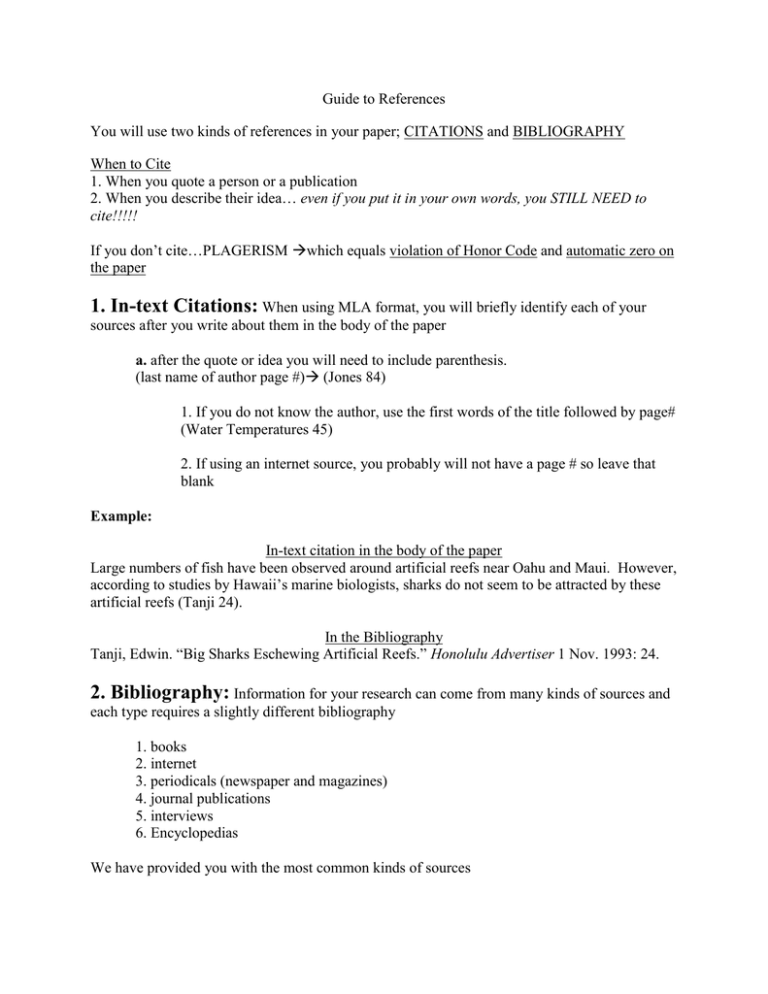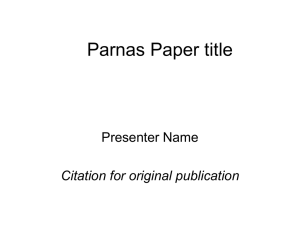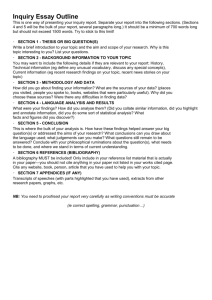Guide to References When to Cite
advertisement

Guide to References You will use two kinds of references in your paper; CITATIONS and BIBLIOGRAPHY When to Cite 1. When you quote a person or a publication 2. When you describe their idea… even if you put it in your own words, you STILL NEED to cite!!!!! If you don’t cite…PLAGERISM which equals violation of Honor Code and automatic zero on the paper 1. In-text Citations: When using MLA format, you will briefly identify each of your sources after you write about them in the body of the paper a. after the quote or idea you will need to include parenthesis. (last name of author page #) (Jones 84) 1. If you do not know the author, use the first words of the title followed by page# (Water Temperatures 45) 2. If using an internet source, you probably will not have a page # so leave that blank Example: In-text citation in the body of the paper Large numbers of fish have been observed around artificial reefs near Oahu and Maui. However, according to studies by Hawaii’s marine biologists, sharks do not seem to be attracted by these artificial reefs (Tanji 24). In the Bibliography Tanji, Edwin. “Big Sharks Eschewing Artificial Reefs.” Honolulu Advertiser 1 Nov. 1993: 24. 2. Bibliography: Information for your research can come from many kinds of sources and each type requires a slightly different bibliography 1. books 2. internet 3. periodicals (newspaper and magazines) 4. journal publications 5. interviews 6. Encyclopedias We have provided you with the most common kinds of sources Books Format: Author. Title of Book. Place of Publication: Publisher, Publication year. Example, one author: Brooks, Charles D. Eating Smart. Boulder, CO: Westview Press, 1982. Example, two or three authors: James, Nancy D., and Mary A. Herbert, eds. Bringing Up Baby. New York: Simon and Schuster, 1972. Example, corporate or government author: Colorado Department of Internal Affairs. Policing the Regulators. Denver: Dept. of Business and Economic Development, 1998. Articles from periodicals (magazines or newspapers) Format: Author. “Title of Article.” Name of Periodical Publication date: Page(s). Examples: Bogart, Humphrey. “Just Whistling.” Newsweek 14 Feb. 1954: 28. “Shop till you Drop.” Consumer Age. Jan. 1999: 12-14. Bekins, Jane. “Terrorism Strikes the City.” New York Times 14 Feb. 1984: A10. Internet - World Wide Web NOTE: Be very careful with Internet sources; many are not reliable. For the purposes of this paper, an Internet source is not considered reliable without an author and page publisher (except with permission of the instructor). If you use a source from the Internet that was originally published in a magazine or newspaper, this will NOT be considered a Web source. Use the format appropriate to the original publication. Format: Author/editor (if known) “Title of Web Page.” Revision or copyright date (if available). Online. Page Publisher. URL (Internet address). Access date. Example: Guffey, Dr. Mary Ellen. “MLA Style Electronic formats.” 6 Feb. 1997. Online. Mary Ellen Guffey’s Communications Resources. www.westwords.com/guffey/sections.html 5 March 1997. Online Research Service Format: Author (if known). “Title of Material Accessed.” Title of Publication. Date of material (if known). Online. Name of Research Service such as ProQuest Direct or Electric Library. Access date. Examples: “Oldfield, Barney, “Stock Market Crash of 1929.” Compton’s Encyclopedia. 1995. Online. Electric Library. 5 March 2000. Best, Grace and Herman Hankins. “Aiming High.” ProQuest Direct. 5 March 1999. Journal of Aviation Jan. 1996. Online. Works Cited Page: A page composed of all your bibliographies listed alphabetically by last name of author or title if author is unknown. 1. double space between sources 2. be sure to INDENT the second line if the bibliography is more than one line!!! EXAMPLE OF WORKS CITED PAGE: (http://owl.english.purdue.edu/owl/resource/747/12/) Works Cited "Blueprint Lays Out Clear Path for Climate Action." Environmental Defense Fund. Environmental Defense Fund, 8 May 2007. Web. 24 May 2009. Clinton, Bill. Interview by Andrew C. Revkin. “Clinton on Climate Change.” New York Times. New York Times, May 2007. Web. 25 May 2009. Dean, Cornelia. "Executive on a Mission: Saving the Planet." New York Times. New York Times, 22 May 2007. Web. 25 May 2009. Ebert, Roger. "An Inconvenient Truth." Rev. of An Inconvenient Truth, dir. Davis Guggenheim. Rogerebert.com. Sun-Times News Group, 2 June 2006. Web. 24 May 2009. GlobalWarming.org. Cooler Heads Coalition, 2007. Web. 24 May 2009. Gowdy, John. "Avoiding Self-organized Extinction: Toward a Co-evolutionary Economics of Sustainability." International Journal of Sustainable Development and World Ecology 14.1 (2007): 27-36. Print. An Inconvenient Truth. Dir. Davis Guggenheim. Perf. Al Gore, Billy West. Paramount, 2006. DVD. Leroux, Marcel. Global Warming: Myth Or Reality?: The Erring Ways of Climatology. New York: Springer, 2005. Print. Milken, Michael, Gary Becker, Myron Scholes, and Daniel Kahneman. "On Global Warming and Financial Imbalances." New Perspectives Quarterly 23.4 (2006): 63. Print



